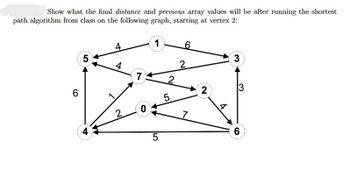Question

Transcribed Image Text:Show what the final distance and previous array values will be after running the shortest
path algorithm from class on the following graph, starting at vertex 2:
1
6
5
4
4
4
2
7
0
5
5
6
2
2
3
13
6
Expert Solution
This question has been solved!
Explore an expertly crafted, step-by-step solution for a thorough understanding of key concepts.
Step by stepSolved in 3 steps with 1 images

Knowledge Booster
Similar questions
- 4-Clique Problem The clique problem is to find cliques in a graph. A clique is a set of vertices that are all adjacent - connected - to each other. A 4-clique is a set of 4 vertices that are all connected to each other. So in this example of the 4-Clique Problem, we have a 7-vertex graph. A brute-force algorithm has searched every possible combination of 4 vertices and found a set that forms a clique: https://en.wikipedia.org/wiki/Clique_problem You should read the Wikipedia page for the Clique Problem (and then read wider if need be) if you need to understand more about it. Note that the Clique Problem is NP-Complete and therefore when the graph size is large a deterministic search is impractical. That makes it an ideal candidate for an evolutionary search. For this assignment you must suppose that you have been tasked to implement the 4-clique problem as an evolutionary algorithm for any graph with any number of vertices (an n-vertex graph). The algorithm succeeds if it finds a…arrow_forwardWe have the following directed graph G, where the number on each edge is the cost of the edge. 1. Step through Dijkstra’s Algorithm on the graph starting from vertex s, and complete the table below to show what the arrays d and p are at each step of the algorithm. For any vertex x, d[x] stores the current shortest distance from s to x, and p[x] stores the current parent vertex of x. 2. After you complete the table, provide the returned shortest path from s to t and the cost of the path.arrow_forwardc) Given the following Graph and after applying Dijkstra algorithm, the final table looks as given below. 16 10 11 12 XXX H 4 18 Fr Vertex known d. T A 7 B T 0 15 H 19 C 41 M J B C D E F G I J JJ K L M T T T T T T T T T T T 6 2 20 5 7 14 31 P G 10 K 30 D G J K T 10 560 From this information, find out the shortest path from the source vertex B to vertex I, trace the path and also find out the shortest distance.arrow_forward
- Kruskal's minimum spanning tree algorithm is executed on the following graph. Select all edges from edgeList that belong to the minimum spanning tree. edgeList result List AD BC BE CF EF DG EG EH GH D 7 9 G 1 B 5 3 A E H 4 2 6 8 Farrow_forwardRun BFS algorithm on the following graph starting with vertex s. Whenever there is a choice of vertices, choose the one that is alphabetically first. What is the order that the vertices are visited? What is the shortest path from vertex s to vertex b?arrow_forwardWhat is the maximum number of edges that can be present in a graph, that has 10 vertices, and has a valid vertex coloring with only 3 colors?arrow_forward
- Alert dont submit AI generated answer. Write a program that reads a weighted graph and an initial vertex.The program must print on the screen the minimum paths obtained by Dijkstra's algorithm. Input: Receives n, m and s; n is the total number of vertices, m the total number of arcs and s is the initial vertex.Next, m lines, each line with a trio of integers, corresponding to the beginning and end of the arc, followed by the weight of the arc.(Vertices are identified from 0 to n-1.) Output: Prints the shortest paths obtained by Dijkstra's algorithm. Exemple: Input: 5 10 00 1 100 4 51 2 11 4 22 3 43 2 63 0 74 1 34 2 94 3 2 Output: [0, 8, 9, 7, 5][-1, 4, 1, 4, 0]arrow_forwardWeighted Graph Applications Demonstration Java Data Structures. Figure 29.23 illustrates a weighted graph with 6 vertices and 8 weighted edges. Simply provide: Minimal Spanning Tree as an illustration or a textual list of edges (in our standard vertex order). Single-Source Shortest Path route from vertex 0 to the other 5 (described as one path/route for each). draw the two solutions and attach the illustration or describe them in text (a list of edges for the one and the vertex to vertex path the other). You can therefore attach proper content files with dot txt, png, jpg or jpeg extensions Be sure the final trees or path lists are clearly visible in your solution. You don't need to show the solution development or progress, just the result.arrow_forwardList the vertices of the following graph in the order they will be visited by each of the following Graph traversal methods starting from vertex A: (a) Breadth-First Traversal: (b) Depth-First Traversal: Note: If at any time you have more than possible vertex to visit, you MUST visit them alphabetically. H. lick this link to disnlay it the imano doos not show utomatically hp EGO 814 LA 7614arrow_forward
arrow_back_ios
arrow_forward_ios